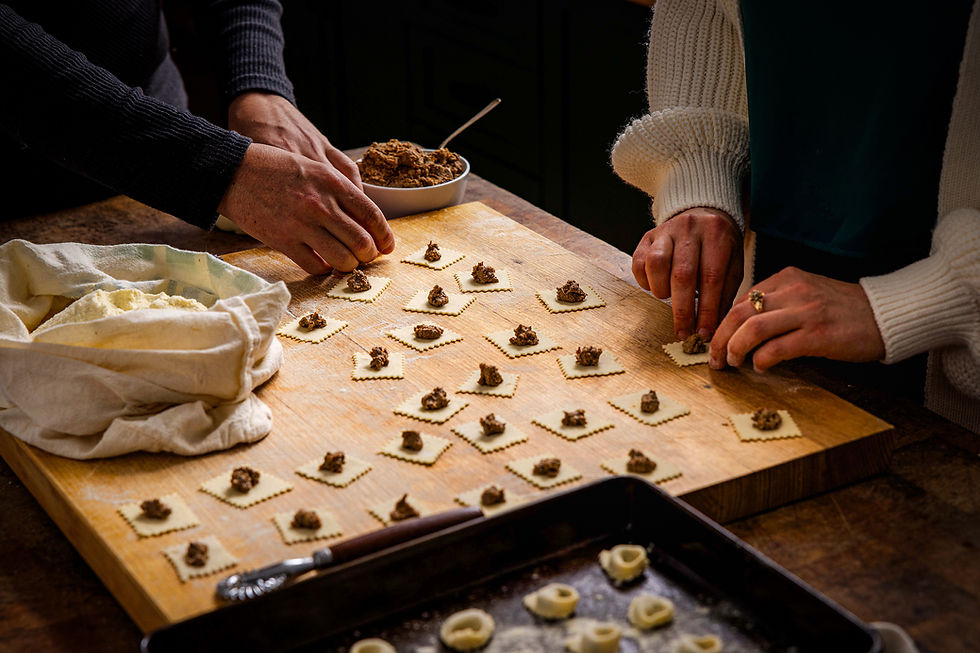Have we romanticised cucina povera?
- Nadia Fragnito

- Apr 9, 2024
- 3 min read
With a growing social consciousness regarding sustainability and plant-based cuisine, has the term 'cucina povera' become idealised without us recognising its bleak origins?

In recent years, cucina povera, or peasant-style cooking (literal translations, 'poor kitchen' or 'poor cuisine') has garnered attention beyond the borders of Italy. This culinary tradition, known for its thrifty, hearty and simple recipes, has found relevance in contemporary food culture.
Concepts like 'zero waste,' 'sustainability,' and emphasising vegetables as culinary heroes have become popularised in food writing, the media, and the restaurant industry.
Amidst the popularity of 'poor cooking,' perhaps it is time to acknowledge its historical context and understand why reusing leftovers and eating plant-based were survival strategies, not mere culinary trends.
Despite some very pure intentions within this movement, have we romanticised a cuisine born out of human suffering?
Cucina povera didn't arise from a desire to follow dietary fads or proclaim one's environmental commitment. Rather, it emerged from a time of profound hardship and poverty, where families had to rely on homegrown or bartered food out of necessity. The dishes that have become symbolic of this culinary tradition—such as brothy soups or handmade pasta with beans—were created to stretch limited resources and fill bellies.

Although cucina povera has been embraced in contemporary gastronomy, it's important to remember the grim realities that shaped it. In many regions across Italy, access to food was a daily struggle, and the luxury of store-bought products was rarely an option. Without the means to supply or grow their own food, families faced hunger.
Scholars like Nadia Postiglione have explored the historical context of peasant cooking in southern Italy, shedding light on the challenging conditions faced by communities like those in Molinara (a village located 100 kilometres inland from Naples). Postiglione's research reveals the realities of life in areas where food scarcity was rife.
‘...Molinara’s population was still dependent on low farming production that hardly provided a varied and balanced diet, and that frequently yielded inadequate income for the improvement of the food regime. In this context, farm produce was destined almost exclusively for family consumption. Legumes, cereals, and vegetables constituted the basics of the Molinarese diet.’ (Postiglione, 2010).
The eventual mass migration of Italians to countries with more abundant food resources, such as Australia, North America, and Argentina, marked a significant shift in their diet, with ingredients like meat, eggs, dairy, sugar and refined flour becoming more accessible. And for those who stayed in Italy, economic improvements from the late ‘50s brought similar changes.
In Delizia: the Epic History of Italians and their Food, writer and researcher John Dickie provides insights into the perspective of Italian migrants from 1884-1918, particularly those who fled Italy for South and North America in order to escape poverty.
'Food certainly shaped the identity of the peasant emigrants from Italy, but the feelings it conjured up were not nostalgic: envy, anger, and ambition marked the attitude to eating when they departed and turned food into a badge of who they were once they arrived.' (Dickie, 2023).
Despite all this, the essence of peasant cooking has endured. In Italian migrant communities worldwide, traditional dishes remain treasured. After settling in Adelaide (South Australia) the Molinaresi community continued to favour vegetables, particularly potatoes. These vegetables weren't just sustenance, as they had been in the past; they also served as a connection to their heritage and identity, ‘Consumption of potatoes in Australia therefore became for the Molinaresi a cultural practice.’ (Postiglione, 2010). After all, they weren't nicknamed 'mangia patane' (potato-eaters) for nothing.
Today, as we embrace the principles of cucina povera, let’s not forget its origins.
It’s more than a label; it's a testament to resilience and resourcefulness.
By embracing simplicity and making the most of economical cooking, we can learn from the traditions of cucina povera and its relevance in a world where the rising cost of food remains a pressing concern for many.
Rather than shopping for a wide array of vegetables, consider fewer, but seasonal varieties. Our minestrone, stir-fries and salads don’t require a Garden of Eden harvest. Some of my favourite dishes, like Pasta e Fagioli, Patate e Spinaci, Zucchine e Pomodori, and Orecchiette con Cime di Rapa, focus on just two ingredients.
In a world where food prices and the cost of living are challenges for many, the lessons of cucina povera ring true. They remind us that simplicity can bring delicious, hearty, and nutritious meals.
And most importantly, we can be thankful that eating simply doesn't mean going hungry.
References:
Dickie, J. (2023). Delizia: the epic history of Italians and their food. p236. Hodder and Stoughton.
Postiglione, N. (2010). 'Mangiavamo all molinarese: a history of food between Molinara and Australia.' Terra Lasci, Terra Trovi: from Molinara to Adelaide, edited by Don Longo). p 78-85. Molinara and Social and Sports Club















The idea of cucina povera — making something extraordinary out of simple ingredients — truly resonates with how creativity works in the digital space too. In a way, it’s like how tools such as the TamilMV Proxy give people access to diverse entertainment and cultural content, even with limited options. Simplicity, when used wisely, always leads to something meaningful and rich — whether it’s in food or technology. 🍝💡
Thank you for educating us and making us mindful of the origins of this. I’m happy it is now an ethical choice rather than a dire necessity today. ❤️